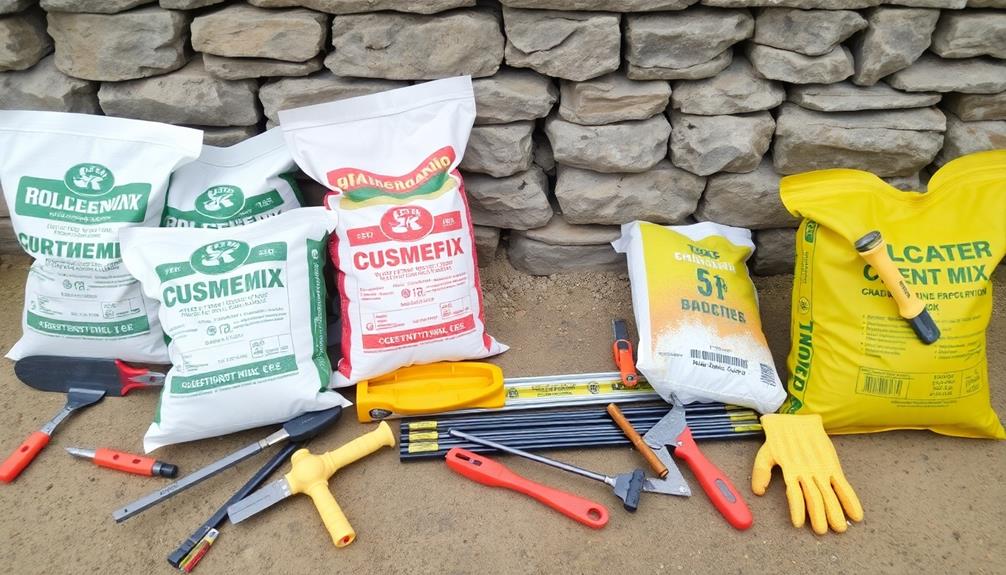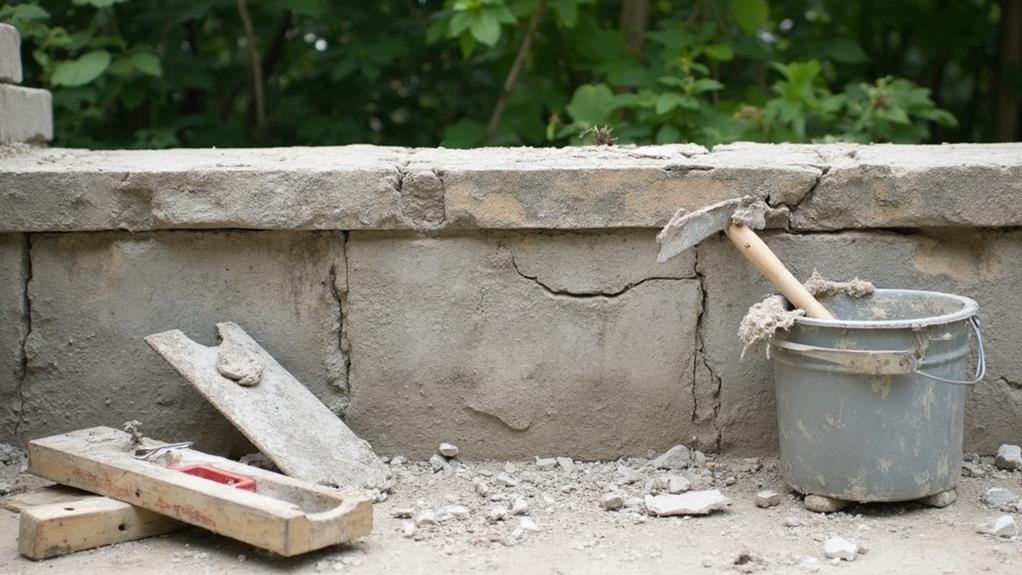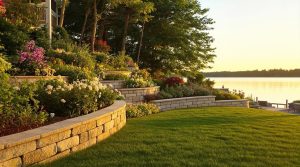Repairing a cracked retaining wall involves identifying the crack type, which could be vertical, horizontal, or diagonal, each indicating different structural and foundational issues. Causes such as hydrostatic pressure, soil movement, and improper construction must be pinpointed to choose the correct remediation approach. Essential repair tools include a chisel, hammer, concrete trowel, and wire brush, while materials like hydraulic cement and fiber-reinforced concrete are used for durable patches. Effective repairs require selecting weatherproof adhesives based on material compatibility and environmental exposure. Understanding these elements will equip you to address potential issues thoroughly and guarantee the wall's longevity.
Table of Contents
ToggleWalls Contractor Highlights
- Inspect the cracks to assess severity, type, and potential underlying structural issues before beginning repairs.
- Clean the crack area using chisel and wire brush for better adhesion of repair materials.
- Apply a high-quality sealant or patch mortar to fill cracks and prevent moisture ingress.
- Improve drainage by installing draining pipes or a French drain to reduce hydrostatic pressure.
- Regularly maintain and inspect the wall to catch early signs of distress and ensure durability.
Define Retaining Wall Cracks

Retaining wall cracks can manifest in varying forms, such as vertical, horizontal, or step-like fissures, each of which indicates different underlying issues and degrees of concern. For example, these walls might involve boulder retaining walls, known for their durability and unique appearance, which can also face similar challenges.
Understanding the causes of these cracks requires examining factors like soil pressure, drainage problems, and thermal expansion, which can compromise the wall's structural integrity over time. Identifying these structural issues early is critical for implementing timely repairs and preventing further deterioration or potential failure of the retaining wall system.
Types of Wall Cracks
Cracks in a retaining wall, often indicators of underlying structural issues, merit careful evaluation. Varied in form and causality, these fissures can foretell potential risks, necessitating precise identification to address concerns effectively.
Horizontal cracks, typically manifesting as straight lines across the wall, frequently suggest pressure exerted by lateral soil movement. Such distortions may hint at the wall's inability to withstand the force of the soil it retains, suggesting imminent danger if left unchecked.
Vertical cracks, on the other hand, often result from foundation settling, where disparate compacting of the soil beneath the wall causes imbalance. These fractures may remain narrow yet deepen over time, indicating subsidence that might compromise the wall's integrity.
Diagonal cracks usually form at 45-degree angles and can signify tension due to differential settlement or indicative shear stresses. The presence of such cracks often suggests movement within the wall that requires attention to avert further damage.
Causes of Crack Formation
Understanding the genesis of cracks in retaining walls is pivotal for devising appropriate remediation strategies. Retaining walls, essential for landscape management and structural stability, succumb to cracks due to numerous factors that undermine their integrity.
One primary cause is the force exerted by hydrostatic pressure. When water accumulates in soil without proper drainage, it generates pressure that can exploit the wall's structural vulnerabilities, leading to cracking. Additionally, soil movement, influenced by changing moisture levels and freeze-thaw cycles, adds stress to retaining walls, causing fissures to form.
Material degradation over time also contributes to crack formation. Concrete and masonry become susceptible to cracking as they undergo expansion and contraction with temperature fluctuations, leading to stress that breaks down structural bonds. Correspondingly, inadequate construction practices, such as insufficient reinforcement or poor-quality materials, can predispose a wall to early failure. Overloading, whether from weight behind the wall or external forces, can exacerbate these issues.
Awareness of these causes not only guides precise remediation but also fosters a sense of community among property owners as they support each other in addressing shared challenges posed by retaining wall maintenance. Through proactive understanding, ongoing concerns transform into manageable efforts, enhancing neighborhood cohesion.
Identifying Structural Issues
A key component of maintaining a retaining wall's integrity is accurately diagnosing structural anomalies such as cracks. Identifying these cracks early can prevent further damage and safeguard the structure.
Retaining wall cracks often manifest in varied forms, each indicative of underlying issues. Horizontal cracks can suggest excessive pressure from soil loads, possibly due to poor drainage or over-saturated soil, while vertical cracks may point to differential settling of the foundation, where sections of the wall have sunk unevenly. Diagonal cracks, on the other hand, could hint at potential sliding failure or increased pressure from the wall's load-bearing function.
To determine the implications of these cracks, it is paramount to evaluate their size, location, and pattern. Hairline cracks might be merely cosmetic, whereas wider or deeper fissures generally signal significant structural concerns requiring immediate attention. Observing and documenting the progression of these cracks over time is vital for thorough assessment.
Engaging a structural engineer or a professional masonry expert can provide valuable insights into the severity of the problem and help inform subsequent repair strategies. By fostering an understanding of these issues, you can maintain not only the aesthetic appeal but also the functional stability of your retaining wall.
Benefits

Repairing a cracked retaining wall yields numerous benefits, including the enhancement of structural integrity, which is essential in preventing further deterioration that could lead to costly and extensive repairs. This process often involves the use of specialized tools and techniques to address any issues effectively and guarantee the safety and stability of the structure.
Additionally, addressing these issues not only safeguards against potential damage but also revitalizes the visual appeal of the landscape, contributing to a more aesthetically pleasing environment. In addition, these improvements have the potential to increase the property's overall value, making it a prudent investment for homeowners.
Improves Structural Integrity
Reinforcing a cracked retaining wall plays an essential role in enhancing its structural integrity, ensuring both safety and longevity. A well-maintained retaining wall is fundamental in preserving not only the landscape it supports but also the trust and confidence of the community relying on its steadfastness. By addressing cracks and implementing reinforcements, such as concrete patching or the application of steel braces, the wall's durability is considerably enhanced, thereby reducing the risks associated with potential collapses or land shifts.
Beyond immediate repairs, the process of reinforcing a cracked retaining wall often involves a thorough analysis of the structural design, allowing for an improved and more robust integration into the surrounding environment. This deliberative approach guarantees that the wall can better withstand natural forces, such as soil pressure and water infiltration, which are common stressors that could compromise its stability. In effect, these enhancements provide peace of mind to all stakeholders—from property owners to community members—by affirming an unwavering commitment to safety and continuity.
Ultimately, fortifying the structural integrity of a cracked retaining wall not only maintains its physical resilience but also fosters a sense of belonging and trust within the community that depends upon its reliability.
Prevents Further Damage
Addressing the prevention of further damage serves as the next logical step after reinforcing a cracked retaining wall for enhanced structural integrity. Shoring up the wall fortifies its foundational elements, ensuring long-term resilience against natural wear and potential catastrophes.
Preventative measures guard against the detrimental effects of erosion, water infiltration, and shifting earth pressures. By undertaking specific strategies, property owners not only elevate their landscape but also build a sense of community pride by contributing to neighborhood stability.
To prevent additional deterioration, consider the following actions:
- Improve drainage systems: Ensuring proper drainage can drastically reduce hydrostatic pressure, thereby lessening the potential for cracks and weaknesses. The installation of draining pipes or a French drain are effective solutions.
- Sealant application: Utilizing high-quality sealants will provide a protective barrier against moisture intrusion. This step mitigates risks associated with water-induced damage, effectively prolonging the wall's lifespan.
- Regular inspections and maintenance: Periodic evaluations by skilled professionals can identify early signs of distress, allowing for timely interventions. Maintenance routines that include cleaning and minor repairs can prevent small issues from escalating.
Enhances Aesthetic Appeal
Frequently, enhancing the aesthetic appeal of a retaining wall becomes a crucial benefit following structural reinforcements. In the context of repairing a cracked retaining wall, the opportunity arises to not only restore its original purpose but to also transform it into an architectural element that contributes to the overall harmony of your landscape. The process of repair allows for the careful selection of high-quality materials and finishes that complement the surrounding environment, making the wall a visually engaging feature.
Moreover, incorporating design elements such as texture variation, color contrast, and plant integration can effectively elevate the wall's aesthetic quality. These enhancements may reflect personal taste and community norms, aligning the structural need with an expression of identity that resonates with the desired sense of belonging.
Furthermore, a well-maintained and visually appealing retaining wall can set a standard of excellence, fostering pride within neighborhoods and communities. It becomes not only a functional asset but an embodiment of diligence and care, positively impacting social cohesion among residents. Hence, the aesthetic revitalization of a retaining wall should be viewed as an integral aspect that transcends mere functionality, reinforcing communal ties through shared environmental beauty.
Increases Property Value
A retaining wall, when properly repaired and aesthetically enhanced, often contributes substantially to increasing property value. For homeowners who take pride in their property's appearance and functionality, a well-maintained retaining wall represents a harmonious blend of beauty and practicality. Such improvement not only safeguards the structural integrity of the land it holds but also elevates the marketability of the home itself, attracting discerning buyers.
When considering the impact on property value, the benefits of repairing a cracked retaining wall can be outlined as follows:
- Improved Curb Appeal: A flawlessly repaired retaining wall, harmonious with the surrounding environment, notably enhances the property's first impression, increasing the likelihood of captivating potential buyers.
- Enhanced Structural Integrity: By addressing foundational cracks, homeowners alleviate concerns about future land shifts or flooding risks, which potential buyers find reassuring in their search for a safe and secure purchase.
- Increased Usable Space: Repairs provide the opportunity to optimize land use, converting previously unstable areas into functional outdoor spaces for landscaping or recreational purposes, adding tangible worth.
For those seeking assurance in their investment, a meticulously maintained retaining wall stands as a record of quality care and forward-thinking home ownership. This thoughtful consideration fosters a sense of community and belonging amongst neighbors and future inhabitants alike.
Common Repair Materials Needed

When addressing the repairs of a cracked retaining wall, selecting the correct materials is paramount for ensuring both the durability and longevity of the repair. Essential tools such as trowels, mixing buckets, and safety gear form the backbone of any repair kit, while durable patch options including hydraulic cement and epoxy sealants offer varied degrees of resilience against environmental stressors. Additionally, the choice of adhesive can greatly impact the structural integrity of the repair, with factors like bonding strength and setting time playing critical roles in the selection process.
| Tool Type | Patch Options | Adhesive Factors |
|---|---|---|
| Trowels | Hydraulic Cement | Bonding Strength |
| Mixing Buckets | Epoxy Sealants | Setting Time |
| Safety Gear | Temperature Tolerance | |
| Measuring Tools | Moisture Resistance |
Essential Repair Tools
Equipping yourself with the right repair tools is essential to effectively mend a cracked retaining wall. Whether you are a seasoned professional or a dedicated DIY enthusiast, having a comprehensive toolkit not only aids in achieving quality repairs but also reinforces a sense of community among those who engage in this practical endeavor. Precision and efficiency are achievable when the fundamental tools are at your disposal.
Below is a curated selection of principal tools for this task:
- Chisel and Hammer – Key for carefully removing any loose or deteriorated concrete from the cracked area. This step confirms that new repair material adheres properly and provides a sound structural bond.
- Concrete Trowel – A pivotal tool for applying repair mortar. It grants the control necessary for smooth application, filling cracks evenly and seamlessly, and promoting the structural integrity of the repaired wall.
- Wire Brush – Employed to clear any residual debris or dust from the surface. This preparatory measure enhances adhesion properties, ensuring that repair compounds set properly and endure over time.
Durable Patch Options
Selecting the right materials is paramount in ensuring a long-lasting repair for a cracked retaining wall. The integrity of such a structure depends heavily upon durable patch options that can withstand environmental stressors while adhering appropriately to existing wall materials.
One primary ingredient often used is hydraulic cement, known for its rapid-setting properties and ability to expand as it cures, consequently sealing the crack effectively and preventing moisture ingress. Additionally, it is highly resistant to water, making it an ideal choice for outdoor applications.
Fiber-reinforced concrete patches are another robust option. Embedded with tiny fibers, these patches offer superior tensile strength, improving the overall durability of the repair. This increased resilience can help the patch withstand thermal expansion and contraction cycles, therefore ensuring the repair's longevity.
Furthermore, polymer-modified repair mortars should not be overlooked. Enhanced with polymers, these mortars boast heightened bonding capabilities and flexibility, both critical traits when addressing cracked retaining walls. Their adaptability allows for a seamless application, creating an impervious seal that integrates well with the existing structure.
Adhesive Selection Tips
Choosing the appropriate adhesive is critical for guaranteeing a reliable and enduring repair of a cracked retaining wall. When selecting an adhesive, it is essential to evaluate the material of the wall, environmental conditions, and the specific nature of the crack. The right adhesive not only provides structural integrity but also helps maintain the aesthetic appeal of your retaining wall.
Material Compatibility: The adhesive must be compatible with the materials of the wall. For instance, a masonry adhesive is ideal for concrete and stone walls, as it contains additives that enhance adherence to these surfaces.
Weather Resistance: Given that retaining walls are exposed to the elements, opting for an adhesive that can withstand varying weather conditions secures longevity. Choose products labeled as waterproof or weather-resistant to withstand seasonal changes.
Application Method: Contemplate the ease of application, whether the adhesive requires a caulking gun or a trowel. Some adhesives are more user-friendly and suitable for DIY repairs, while others might require professional assistance.
Walls Contractor FAQ
What Are the Causes of Retaining Wall Cracks?
Retaining wall cracks can arise from soil pressure, poor drainage, temperature fluctuations, or improper construction. Understanding these causes allows for effective measures in prevention and repair, fostering a sense of community through shared knowledge and collective maintenance efforts.
How Long Does a Typical Repair Process Take?
The duration of a typical repair process varies based on factors such as the extent of damage and material involved. Generally, repairs can range from several days to a few weeks, ensuring thorough/complete/extensive restoration while fostering trust within the community.
Can Severe Cracks Be Repaired by an Amateur DIYER?
While ambitious, it is not advisable for an amateur DIYer to tackle severe cracks, as specialized knowledge and tools are pivotal. Ensuring structural integrity requires expertise, fostering a safe and supportive environment for our community.
Are There Specific Contractors for Retaining Wall Repairs?
Retaining wall repair typically requires specialized expertise. Contractors who focus on these projects possess the necessary skills and experience. By engaging a professional, property owners guarantee structural integrity, fostering long-term stability and peace of mind within their community.
What Is the Cost Range for Professional Repairs?
The cost range for professional structural repairs varies widely, often influenced by factors such as material, damage extent, and location. Generally, estimates range from $500 to $10,000, encompassing inspection, materials, and labor, ensuring meticulous restoration and safety compliance.







